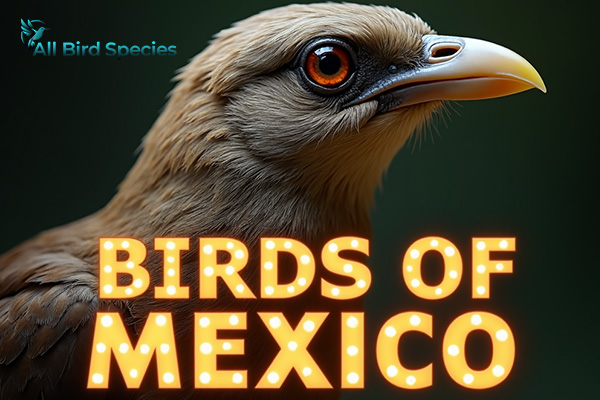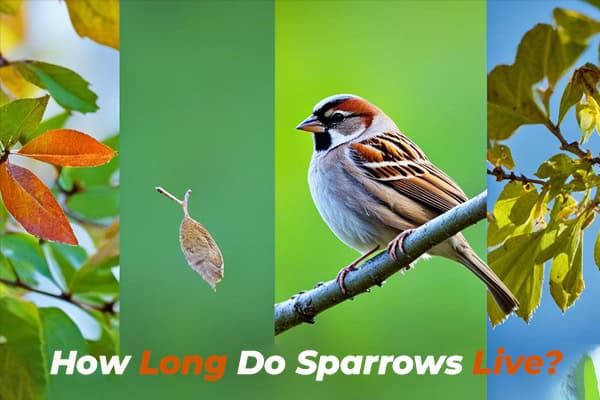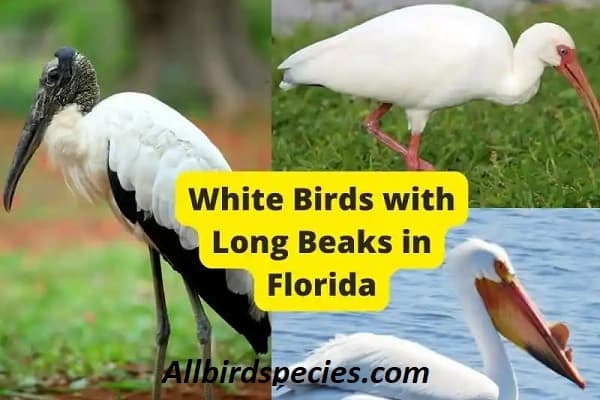16 Types of Black and White Birds in the UK (With Photos)
Did you know the UK is home to over 500 types of Black and White birds? About 30% of them have striking black and white feathers. This shows how elegant and simple these birds are. We’ll look at 28 types of black and white birds in the UK. They range from garden birds to majestic seabirds.
Even though the UK is known for colorful birds, black and white ones are crucial to our ecosystems. They live in cities, by the coast, and in forests. These birds make our surroundings more beautiful and play a big role in keeping our environment balanced. We’ll use photos to show how amazing these bird species are and why we need to protect them.
Introduction to Black and White Birds
Let’s start our journey into the world of black and white birds. They have a unique charm and play a big role in the UK. These birds make the landscape more interesting, from city life to quiet countryside.
While birdwatching in the UK, we see these birds in many places. Each one has its own way of living and adapting. Their black and white feathers make them stand out, adding beauty to the green surroundings.
Learning about their eating habits and how they nest helps us appreciate them more. It’s important to watch over these birds. This way, we make sure they’ll still be around for others to see in the future.
1. House Martin
- Scientific Name: Delichon urbicum
- Lifespan: Approximately 3-5 years
- Size: About 13 cm
- Weight: 15-20 g
- Wingspan: 26-29 cm
- Population: 510,000 breeding pairs
- Typical Habitat: Urban and suburban areas, often building nests on structures
- Conservation Status: Red (indicating concern)
House Martins are known for their sleek look and white belly. They love urban life, especially in the spring and summer when they nest on buildings. These birds fly in groups and do amazing aerial stunts to catch insects. Sadly, their numbers are dropping, so conservation efforts are needed to help them.
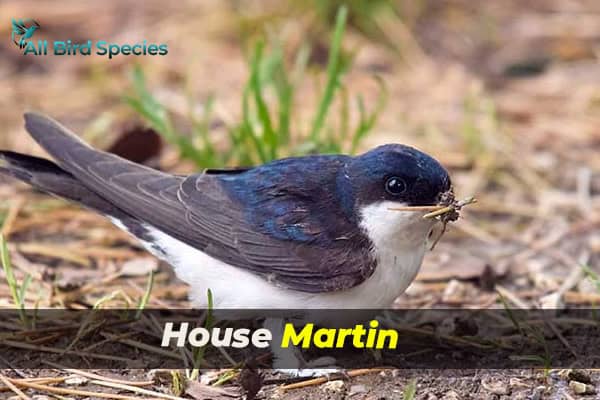
2. Gannet
- Scientific Name: Morus bassanus
- Lifespan: Approximately 20-30 years
- Size: About 90-110 cm
- Weight: 2.2-3.6 kg
- Wingspan: 165-180 cm
- Population: 220,000-295,000 nest sites
- Usual Habitat: Coastal cliffs and open seas
- Status: Amber
The Gannet, known as Morus bassanus, is a large seabird known for its diving skills. It plunges from high into the ocean to catch fish, using its streamlined body to move through the water. They nest on steep cliffs, forming large colonies where their white feathers stand out against the sea.

Their social nature and aerial displays make them a joy to watch.
3. Black-legged Kittiwake
- Scientific Name: Rissa tridactyla
- Lifespan: 15-25 years
- Size: 37-41 cm
- Weight: 305-525 g
- Wingspan: 91-96 cm
- Population: 380,000 pairs
- Usual Habitat: Coastal cliffs and islands
- Status: Red
The Black-legged Kittiwake (Rissa tridactyla) is known for its gentle nature and black legs. They prefer to nest on cliffs and islands, avoiding crowded areas. Their soft calls add to the peacefulness of the beach.

They build nests from seaweed and small stones, showing a strong bond with the sea.
4. Oystercatcher
- Scientific Name: Haematopus ostralegus
- Lifespan: 15-30 years
- Size: About 40-45 cm
- Weight: 350-550 g
- Wingspan: 83-90 cm
- Population: 96,000 breeding pairs
- Usual Habitat: Coastal areas, estuaries, and shorelines
- Status: Amber
Oystercatchers (Haematopus ostralegus) are colorful birds found on beaches and rocky shores. Their bright orange bills and legs make them stand out. They eat mollusks and crustaceans, using their strong bills to open shells.
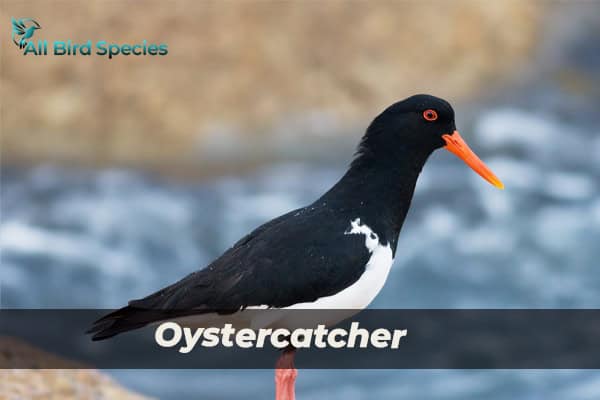
They are social birds, often seen in groups, adding charm to the coast.
| Species | Scientific Name | Nesting Habitat | Feeding Behavior |
|---|---|---|---|
| Gannet | Morus bassanus | Coastal cliffs | Dives for fish |
| Black-legged Kittiwake | Rissa tridactyla | Coastal cliffs and islands | Feeds on fish |
| Oystercatcher | Haematopus ostralegus | Sandy beaches, rocky shorelines | Pries open mollusks |
Woodland Dwellers: Black and White Birds in the UK
Woodlands in the UK are home to many black and white birds. Each one has its own look and way of living. We’ll look at three special birds: the Great Spotted Woodpecker, the Lesser Spotted Woodpecker, and the Long-tailed Tit. These birds help keep their homes healthy and are fun to watch for bird lovers.
5. Great Spotted Woodpecker
- Scientific Name: Dendrocopos major
- Lifespan: 5-6 years
- Size: Approximately 23 cm
- Weight: About 70-90 g
- Wingspan: 34-39 cm
- Population: 140,000 breeding pairs
- Usual Habitat: Woodlands and gardens
- Status: Green
The Great Spotted Woodpecker has a black and white look with a bright red spot on the male’s head. It’s known for its loud drumming in the woods. It eats insects, like beetles, from tree bark. Seeing this bird in the UK’s woods is a treat.

6. Lesser Spotted Woodpecker
- Scientific Name: Dryobates minor
- Lifespan: 2-3 years
- Size: Around 15 cm
- Weight: Approximately 20-30 g
- Wingspan: 25-30 cm
- Population: 800-1000 breeding pairs
- Usual Habitat: Woodlands and parks
- Status: Red
The Lesser Spotted Woodpecker is smaller and harder to see than its big brother. It’s less common and its numbers are going down. It has a simple black and white look that helps it hide in trees. It eats small insects and larvae. We need to pay more attention and help protect this bird.
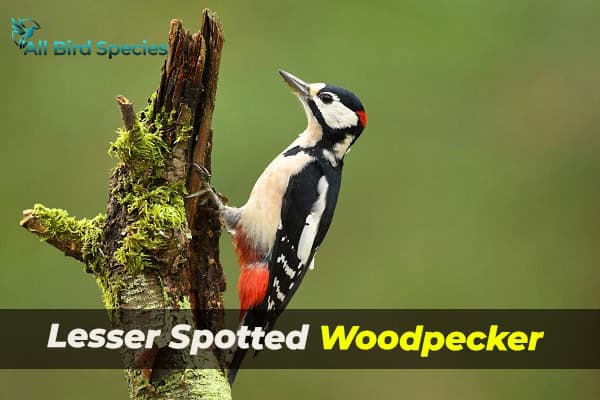
7. Long-tailed Tit
- Scientific Name: Aegithalos caudatus
- Lifespan: 3 years
- Size: 14cm
- Weight: 5-8g
- Wingspan: 22-24cm
- Population: 340,000 breeding territories
- Usual Habitat: Woodlands, hedgerows, and gardens
- Status: Green
The Long-tailed Tit has a big, fluffy body and a long tail. It moves through trees looking for insects and seeds, often with friends. Their fun behavior and black and white look make them popular in gardens too. Watching these birds in UK woodlands is a joy.
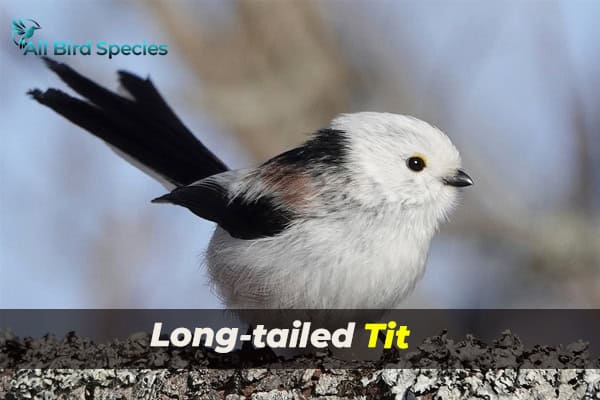
Black and White Waders of the UK
Wading birds in the UK are truly fascinating, with their striking black and white looks. The Lapwing and the Barnacle Goose stand out, each with its own story. Learning about their homes, actions, and conservation helps us understand more about wildlife in farmland and by the coast.
8. Lapwing
- Scientific Name: Vanellus vanellus
- Lifespan: 5-10 years
- Size: Approximately 28-33 cm
- Weight: 140-280 g
- Wingspan: 67-77 cm
- Population: 98,000 breeding pairs
- Usual Habitat: Farmlands, wet grasslands, and lakesides
- Status: Red
The Lapwing is known for its eye-catching black and white feathers and a special crest. It was once common in the countryside but has sadly become less so due to farming changes. They live in open fields, where their eggs are hard to see. Efforts are being made to protect their homes and help these beautiful birds survive.
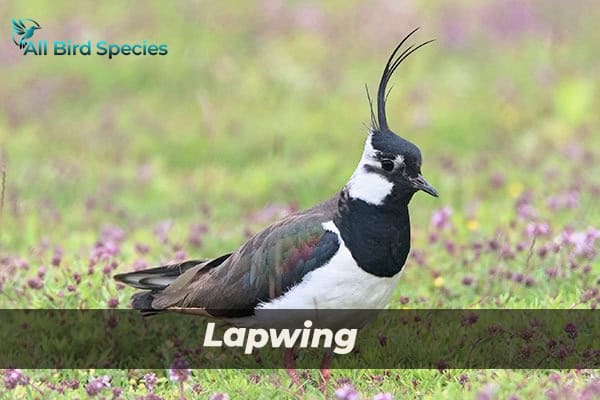
9. Barnacle Goose
- Scientific Name: Branta leucopsis
- Lifespan: Approximately 10-20 years
- Size: About 55-70 cm
- Weight: 1.2-2.3 kg
- Wingspan: 130-145 cm
- Population: 1,550 breeding pairs
- Usual Habitat: Coastal areas, tundra, and wetlands
- Status: Amber
The Barnacle Goose is mostly a winter visitor but is now seen more often in the UK all year. They are easy to spot with their black head and white cheeks. These birds travel in big groups from the Arctic to the UK for the winter. Saving their homes and teaching people about their importance is key to their survival.

10. Rook
- Scientific Name: Corvus frugilegus
- Lifespan: 10-15 years
- Size: Around 45 cm
- Weight: Approximately 400 g
- Wingspan: 81-100 cm
- Population: 1,100,000 breeding pairs
- Usual Habitat: Farmlands, woodlands, and urban areas
The Rook (Corvus frugilegus) loves to be around others, often foraging in fields with friends. These birds look for insects, seeds, and more in large groups. This helps keep pests away from crops, which is good for farmers.

Rooks live in big groups and build big nests in trees. They have a steady population, playing a key role as scavengers in their area.
11. Hooded Crow
- Scientific Name: Corvus cornix
- Lifespan: 6-8 years
- Size: Approximately 48 cm
- Weight: Around 400 g
- Wingspan: 85-100 cm
- Population: 285,000 breeding territories
- Usual Habitat: Open country, farmlands, and urban areas
- Status: Green
The Hooded Crow (Corvus cornix) is very smart and lives in both cities and the countryside. It’s great at finding food, and eating everything from dead animals to small mammals and scraps. This bird is known for solving problems to survive.
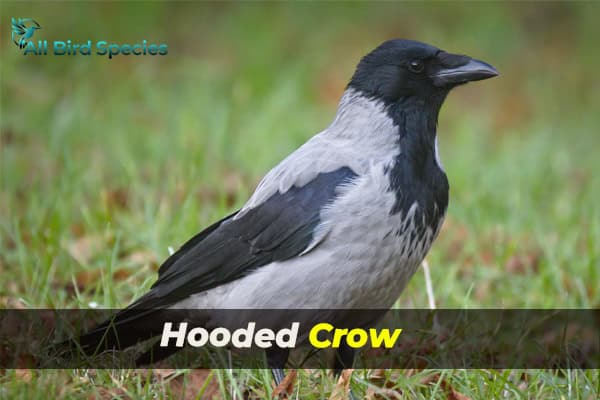
They make their nests in trees or by the coast, showing off their smarts in finding food for their babies.
| Characteristic | Rook | Hooded Crow |
|---|---|---|
| Scientific Name | Corvus frugilegus | Corvus cornix |
| Social Behavior | Highly sociable, forages in groups | More solitary, can be social |
| Diet | Insects, seeds, carrion | Carrion, small mammals, food scraps |
| Nesting Habits | Colonial nests in trees | Nests in trees or coastal areas |
Rarest Black and White Birds: Spotlight on the Uncommon
In the UK, two black and white birds are quite rare: the Goldeneye and the Little Gull. They are not just beautiful but also show the UK’s rich biodiversity and conservation work.
12. Goldeneye
- Scientific Name: Bucephala clangula
- Lifespan: Approximately 10-15 years
- Size: About 40-51 cm
- Weight: 500-1,200 g
- Wingspan: 66-76 cm
- Population: 200 breeding pairs
- Usual Habitat: Freshwater lakes, rivers, and coastal areas
- Status: Red
The Goldeneye is a stunning black and white diving duck. It has bold colors and a bright yellow eye. It’s not common, with about 200 breeding pairs in the UK. They live in freshwater places like lakes and rivers, especially when breeding.

These ducks eat aquatic insects and small fish. They hunt by diving in the water.
13. Little Gull
- Scientific Name: Hydrocoloeus minutus
- Lifespan: Approximately 10-20 years
- Size: About 25-30 cm
- Weight: 100-200 grams
- Wingspan: 75-80 cm
- Population: Estimated at 130,000-200,000 breeding pairs
- Typical Habitat: Coastal regions, freshwater lakes, and marshes
The Little Gull is the smallest gull in the UK. It has a unique black head. Birdwatchers love to spot these during migration. They live near the coast and big lakes.

They nest in groups, which is quite charming. The Little Gull is important for checking on the environment’s health. Conservation groups work hard to protect their homes.
| Species | Habitat | Breeding Pairs in the UK | Diet | Conservation Status |
|---|---|---|---|---|
| Goldeneye | Freshwater lakes and rivers | ~200 | Aquatic insects, small fish | Uncommon |
| Little Gull | Coastal areas, large inland waters | Variable during migration | Insects, small fish | At risk |
The Goldeneye and the Little Gull are key to understanding the environment’s health. Conservation efforts are in place to protect them for the future.
14. Black Guillemot
- Scientific Name: Cepphus grylle
- Lifespan: 10-20 years
- Size: Around 30-35 cm
- Weight: 320-450 g
- Wingspan: 54-58 cm
- Population: 20,000 breeding pairs
- Usual Habitat: Coastal cliffs and rocky shores
- Status: Amber
The Black Guillemot is a seabird that changes its appearance with the seasons. During the summer, it is mostly black with noticeable white patches on its wings.
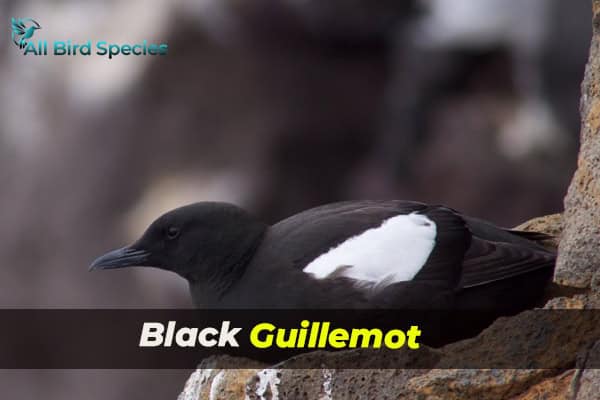
In winter, however, the Black Guillemot’s feathers turn almost completely white. Unlike other seabirds that travel far out to sea, the Black Guillemot tends to stay closer to shore, leading to a more settled lifestyle.
15. Black-headed Gull
- Scientific Name: Chroicocephalus ridibundus
- Lifespan: 5-15 years
- Size: About 38-44 cm
- Weight: 150-300 g
- Wingspan: 94-105 cm
- Population: 140,000 breeding pairs
- Usual Habitat: Lakes, rivers, and coastal areas
Even though Black-headed Gulls are commonly seen, they are facing challenges, much like other gull species in the UK.

Here’s something you might not know: these gulls don’t have a black head all year round. During certain times, their heads turn white, making them easy to mistake for common gulls.
Check Our Previous Articles:
| Hawks in Utah |
| Birds Eating Fish |
| Winter Migratory Birds of Florida |
| Common Woodpigeon |
| Woodpeckers in Montana |
| Hawks in Wisconsin |
16. Great Black-Backed Gull
- Scientific Name: Larus marinus
- Lifespan: Approximately 20-30 years
- Size: About 72-78 cm (28-31 in)
- Weight: 1.5-2.3 kg (3.3-5.1 lbs)
- Wingspan: 145-170 cm (57-67 in)
- Population: 15,000 breeding pairs
- Usual Habitat: Coastal areas, cliffs, and islands
The Great Black-Backed Gull is like a larger version of the Lesser Black-Backed Gull.
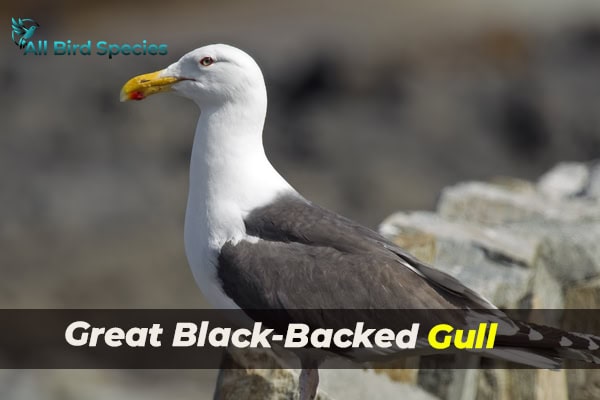
However, you won’t confuse the two. The Great Black-Backed Gull is noticeably bigger, and you’ll usually spot them near the coast, not at inland sites like landfills where the Lesser Black-Backed Gulls are often found.
Conservation Status of Black and White Birds
It’s crucial to understand the conservation status of black and white birds in the UK. Studies show worrying trends due to habitat loss, climate change, and human actions. We must focus on species at risk and efforts to help them. This helps us see the balance of our ecosystem and the challenges these birds face.
Understanding Population Trends
Some black and white species are seeing big declines. The Lesser Spotted Woodpecker is at risk due to habitat loss and poor monitoring. Yet, Magpies are doing well, even in cities. Knowing these trends helps us understand the impact of bird conservation in the UK.
Species at Risk in the UK
Awareness is vital. Supporting bird conservation in the UK means focusing on habitat restoration and protection. By joining local conservation efforts, we can protect endangered species for the future. Let’s work together to save our black and white bird friends.
Conclusion
As you can see, the UK is home to plenty of black and white birds. Keep in mind, that this list doesn’t include rare visitors, like the Smew, or those that only show up in winter. Many birds in the UK are gray and white or black and gray, like Jackdaws.
So, enjoy exploring the world of black and white birds—there are plenty to discover in the UK!



